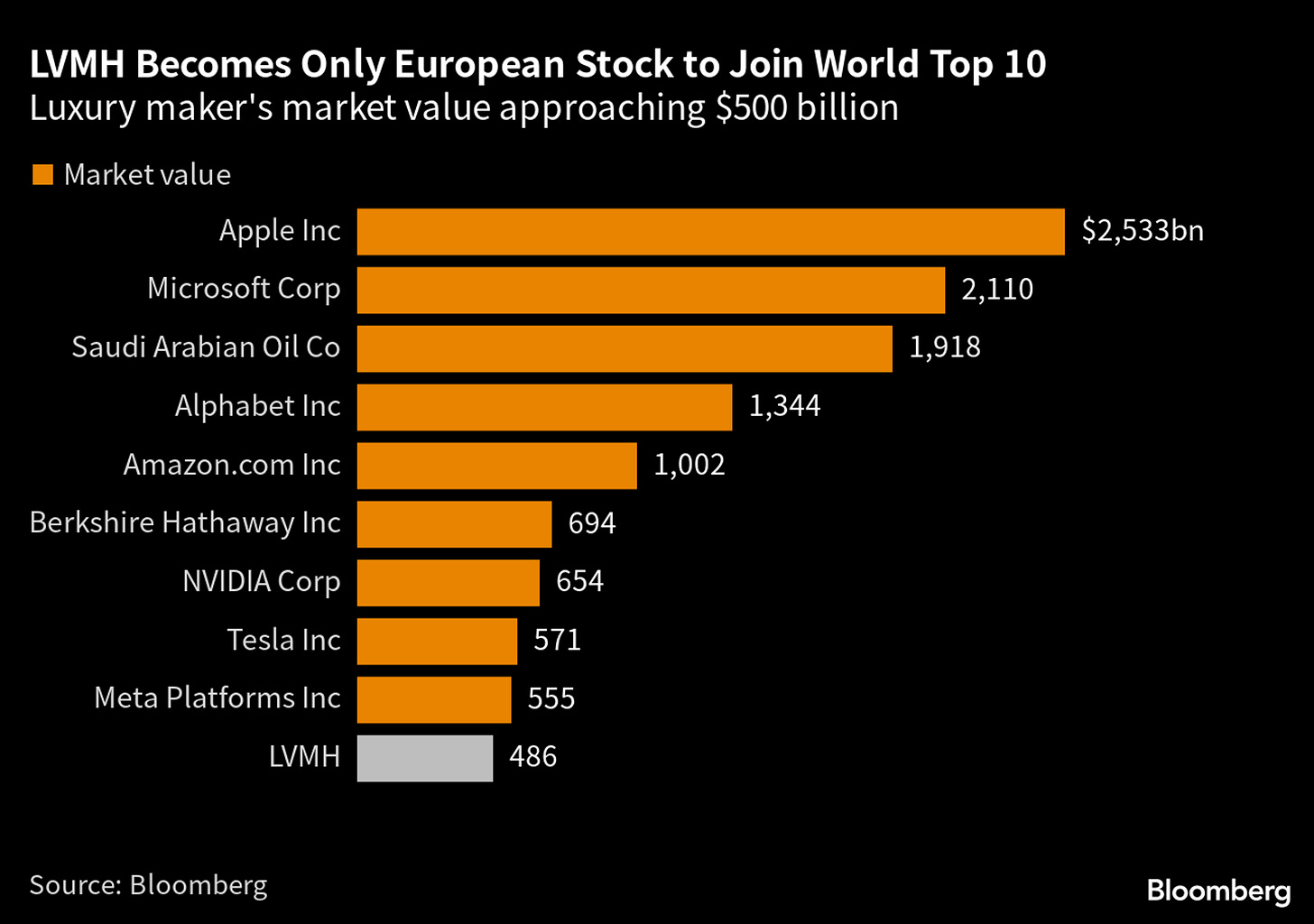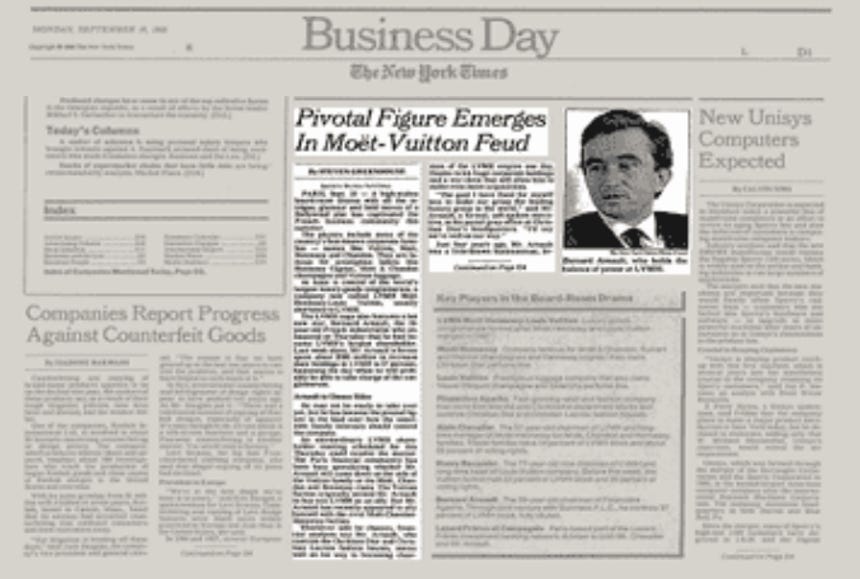LVMH: Part 1 - The Journey
A little bit about its founding journey, unique business model (magic sauce) & cultural differences with Hermès.
Disclaimer - This primer is for inspirational & educational purposes only 💡
Its not investment advice. Figures are from public sources. Opinions are of the author, subject to change over time and may not be updated. Written by Karl Poonawala in Oct ‘23
Its not investment advice. Figures are from public sources. Opinions are of the author, subject to change over time and may not be updated. Written by Karl Poonawala in Oct ‘23
Full series:
Part 1. The Journey 👈
Part 2. The Business Model
Part 3. Hermès Comparison (the anti LVMH?)
wtf is LVMH? 🤔
the world’s most valuable luxury group, 75+ brands, ~€79bn revenue in 2022;
(i) Fashion & leather (14 houses, ~€39bn rev in 2022)
(ii) Wines & spirits (25 houses, ~€7bn rev in 2022)
(iii) Perfumes & cosmetics (15 houses, ~€8bn rev in 2022)
(iv) Watches & jewellery (8 houses, ~€11bn rev in 2022)
(v) Selective retail (6 houses, ~€14bn rev in 2022)
(vi) Other luxury businesses like hotels & yachts (6 houses)
built by Bernard Arnault, over 40+ years, he is known to deploy financial engineering to acquire family-run, luxury brands…
but instead of selling them for a profit (like PE), he combines them under roof to leverage huge economies of scale
his ‘house of brands’ approach has helped LVMH outperform & out-survive its competition
today its Europes most valuable company, with a market cap ~$400bn (as of Nov 2023)
he has proven that luxury brands can be hugely profitable, scaled businesses and not just niche, family-run boutiques
LVMH Group performance:
Louis Vuitton (single brand) revenue & EBITDA:
THE JOURNEY
Phase 0: Beginning
Arnault’s early days
1971 - graduates as an engineer from École Polytechnique (Paris), starts working for family’s construction business
at ~25 years old, takes over the business & shifts focus; from industrial construction to a niche building vacation homes
moves to the US to expand in 80s, inspired by:
financial engineering of the private equity & leveraged buyout era - a stark difference from highly socialist France at the time
how timeless & ubiquitous luxury brands can be, across borders
he started scouting for new opportunities outside real estate
🚘 Bernard Arnault recounts an interaction with a NYC driver in the 80’s: ”He could not name the president…but he knew Dior”, indicating that heritage brands transcend culture.
Phase 1: Dior, gem in a hay stack
His first acquisition
👗 Side note on history of Dior brand:
1946 - founded by a 40-year old Christian Dior & financially supported by Marcel Boussac (a textile magnet). Finds immediate success & grows rapidly given its voluptuous designs were a stark contrast from post-war, boxy fashion
1955 - Christian Dior hires a 19 year old assistant called….Yves Saint Laurent 🤯
1957 - Christian passes away suddenly, leaving 21-year old, Yves, in charge
1960 - despite evolving the brand (making pantsuit fashionable), Yves is fired prompting the start of his own eponymous brand (YSL)
late 1960’s - Dior (& the Boussac parent) is in decline; result of reckless expansion through licensing, impacting quality & buying experience
1967 - Dior Perfumes division sold off to Moet-Hennessey
1978 - group files for bankruptcy (largest in French history), the government takes over, but struggles to manage it for years, until…
1984 - a 35-year old Arnault learnt that Christian Dior is up for (distressed) sale
1984 - Arnault acquires the failing Boussac Group from the government for $60mm ($15mm of family money with $45mm from Lazard Bank)
with Dior is buried deep inside the group, he immediately restructures;
(i) slashes the workforce by ~half
(ii) disposes off struggling textile operations, to reduce cash burn
(iii) sells the profitable disposable-diaper business, to raise growth capital
1987 - just Dior Couture & retailer Le Bon Marché remain + $500mm cash for expansion
Phase 2: LVMH takeover drama
Most important acquisition to date
👑 Side note on history of Louis Vuitton (the person & brand):
1821 - Louis is born to an extremely poor family, runs away becoming homeless at age 13
1830’s - gets apprenticeship with a bag maker and works his way up, until…
1854 - founds his own company, developing a niche in custom luggage sets for French aristocrats (Napoleon III’s wife)
Over decades, he innovates with:
(a) rectangular trunks (instead of traditional round shape) - easier to stack on top of each other during train travel
(b) distinctly coloured + strong canvas - materials helped bags stand out to identify and protect the valuable items inside
It slowly evolves from serving just royalty to any other rich individuals
1977 - Henri Racamier takes over the company when LV had only 2 stores, selling mostly through other retailers, clocking $12mm revenue
he forward integrates; starts operating more stores (to absorb margin & control the shopping experience) + expands globally (Japan)
1984 - LV goes public, $153mm revenue and 125 stores globally
1988 - only 4 years later, hits ~$1bn in revenue
1980’s - investor activism grows, scaring independent public companies
1987 - Louis Vuitton merges with drinks group Moët-Hennessy in a hastened, ‘shotgun’ marriage to rest fears of a hostile corporate takeover (the irony…)
at the time, Moët-Hennessy group owns France’s leading champagne brand, built by Alain Chavelier through a string of mergers
within 6 months, disagreements emerge between the two CEOs (Racamier & Chavalier) over petty maters, like stationary 🤯
tensions rise & both drive their own expansion plans
one side - Moët-Hennessy’s Chavalier seeks support from Guinness (UK drinks behemoth)
other side - LV’s Racamier approaches Bernard Arnault to take a 25% stake in merged company, as a ‘white knight’ (unknowingly letting the wolf in the house)
Bernard approaches his bankers, Lazard, who suggest tying up with Guinness instead to grab the entire group (not just LV)
July 1988 - Guinness & Bernard Arnault create a JV, spend $1.5bn to purchase 24% of LVMH
spend another $600mm, increasing ownership to 37.5%, with veto on board matters
intense public fighting, with Racamier & Chavalier’s attempting to re-break up the group
Dec 1998 - Arnault cements control with 43.5% ownership + 35% voting rights
early 1999 - the two previous CEOs resign. Arnault wins.
Phase 3: Growing the brand
Arnault drove key strategic changes at Louis Vuitton during the 90’s
1. Shifts focus from trunks 🧳 to handbags 👜
handbags occupy a more central role in a woman’s outfit, used more regularly, with range of outfits, increasing the willingness-to-pay (becoming a style accessory vs pure function)
the higher frequency of use enabled LV to cross-sell different designs to each customer (higher profitability per customer, once acquired)
handbags had a simpler production process than canvas trunks (with widespread availability of leather, a by-product of beef)
easier to sell, demanding less storage & no need to try or require perfect sizing / modification
💰 Handbags offer better margins than dresses, trunks & perfumes. Today LV handbags sell at at least 13x the cost of goods to make.
2. Drives vertical integration, in both directions:
(a) Backward integration
increases LV-owned factories from 5 to 14, limits 3rd party manufacturing
→ more control over product quality
(b) Forwards integration
innovates with shop-in-shop concept (= leasing space inside department stores, not just selling to them as a wholesaler)
improves service at company-owned-&-operated stores
→ more control over the shopping-experience
Result = expanded margins & enhanced brand value
🏭 "If you control your factories, you control your quality. If you control your distribution, you control your image.” - Arnault
3. Focus on selling ‘desire’, not added utility:
Arnault reinvigorated marketing to differentiate luxury from ‘premium’, & appeal to those beyond the niche of über wealthy aristocrats
invested in selling a desirable experience, not a product
❗❓Premium vs Luxury…what’s the diff?
Premium brands - where incremental price is related to additional functionality (value-of-use).
Ex; Apple, Mercedes, BMW, Nike, Starbucks, Massimo Dutti, Hyatt, business-classLuxury brands - pricing not necessarily related to higher functionality…in fact, may be less practical (a Ferrari vs Toyota) but related to a desire or feeling of using the product i.e. irrational pricing
Ex; Rolex, B&O, Ferrari, Lamborghini, Hermes, Aman Resorts, first-class💬 “luxury is a necessity that begins where necessity ends“ - Coco Chanel
Phase 4: 60+ acquisitions over 30 years
Repeating a similar playbook
Full acquisition timeline & details - https://www.thefashionlaw.com/lvmh-a-timeline-behind-the-building-of-a-conglomerate/
Continue reading:
Part 3. Hermes Comparison (the anti LVMH?)
Other Mental Models:
Sources:
Source: LVMH: A Timeline Behind the Building of the World’s Most Valuable Luxury Goods Group, The Fashion Law, 2021
https://www.lvmh.com/shareholders/agenda/2022-full-year-results/
https://www.joincolossus.com/episodes/65463636/billinger-the-wolf-in-cashmeres-maison?tab=transcript
https://www.joincolossus.com/episodes/53923319/urquhart-hermes-bags-of-style
https://www.thefashionlaw.com/hermes-vs-lvmh-a-timeline-of-the-drama/
https://www.ft.com/content/21f64410-9117-11e9-aea1-2b1d33ac3271
https://www.amazon.com/Taste-Luxury-Bernard-Arnault-Moet-Hennessy/dp/0747512027
https://www.nytimes.com/2003/11/05/business/2-key-figures-in-gucci-s-turnaround-are-quitting.html
https://www.nytimes.com/2001/09/11/business/pinault-wins-long-battle-to-control-gucci-group.html
https://www.thefashionlaw.com/hermes-vs-lvmh-a-timeline-of-the-drama/
https://martinroll.com/resources/articles/strategy/hermes-the-strategy-behind-the-global-luxury-success/#:~:text=Thierry Hermès founded the company,and other leather riding gear.
https://www.ft.com/content/12a03e2c-ff71-11e8-ac00-57a2a826423e
https://www.ft.com/content/bc6b69ce-29a1-11e7-9ec8-168383da43b7
https://cpp-luxury.com/why-luxury-groups-have-become-real-estate-developers/















